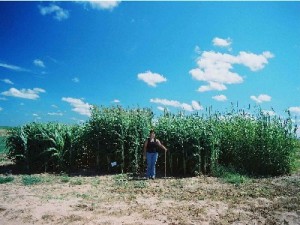Sorghum is an important annual warm-season crop in the southern Great Plains, used for silage, hay, and biofuel production. Overwintering types of sorghum may extend the period of biomass production and reduce production costs.
Rationale
Sorghum originates from semi-arid tropics. It is generally sensitive to low temperature stress and will suffer chilling injury at 10-15°C. While early season selection for cold tolerance in sorghum is a desirable trait for extending its production range and minimizing risks linked to early spring planting, selection for overwintering will be an additional boost for biomass production potential in temperate climates.
Research by Clegg et al. (1983) has shown that genetic variability exists in sorghum for cold tolerance when in mature plant stage. Overwintering capability in sorghum may increase its importance as an alternative biomass crop to corn, and a perennial source of biomass for biofuel production.
Objectives
The main objective of this project is to determine candidate sorghum lines with overwintering capability in environments of the southern Great Plains classified as USDA Zone 7. In the next step, these lines will be used to create new cultivars of sorghum with a perennial type of growth.
This research project is planned to begin in spring 2010.
